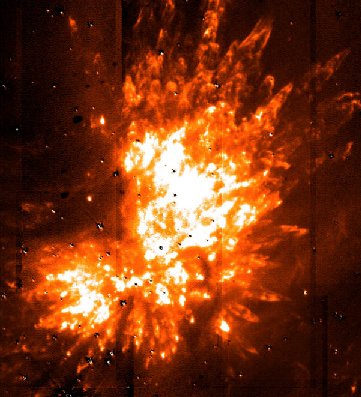Explanation: The most active part of the Orion Nebular Cloud Complex is an area known as the Kleinmann-Low Nebula. There, a cluster of young and forming stars is embedded in a molecular cloud filled with dust. In visible light, the dark dust blocks much of Orion KL's light, but in the infrared light of the above photograph, the area seems literally to explode. Hot stellar winds flowing off massive young stars in Orion KL region permeate and heat surrounding gas, causing finger-like intrusions. Near the center of Orion KL is IRc2, a particularly active star estimated to have over 30 times the mass of our Sun. Radio telescopes have recently detected unusual emission from water molecules - maser radiation from the Kleinmann-Low Nebula.
1999 2000 2001 2002 2003 2004 2005 2006 2007 2008 2009 2010 2011 2012 2013 2014 2015 2016 2017 2018 2019 2020 2021 2022 2023 2024 2025 |
Yanvar' Fevral' Mart Aprel' Mai Iyun' Iyul' Avgust Sentyabr' Oktyabr' Noyabr' Dekabr' |
NASA Web Site Statements, Warnings, and Disclaimers
NASA Official: Jay Norris. Specific rights apply.
A service of: LHEA at NASA / GSFC
& Michigan Tech. U.
|
Publikacii s klyuchevymi slovami:
nebula - molecular cloud - tumannost'
Publikacii so slovami: nebula - molecular cloud - tumannost' | |
Sm. takzhe:
Vse publikacii na tu zhe temu >> | |
